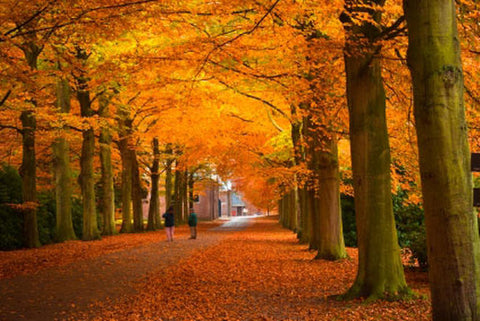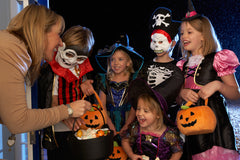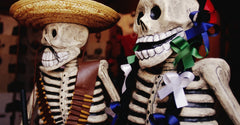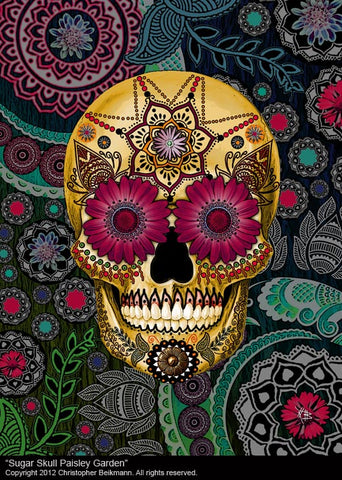Cultural Fusion Holidays - Origins of The Day of the Dead, Saints, Souls, Samhain and Halloween
It is no coincidence that "All Saints Day" and "All Souls Day" (November 1st & 2nd) are aligned with the Mexican Days of the Dead - "Dia De Los Angelitos" and " Dia De Los Muertos". It is also no coincidence that they take place in the two days following "Halloween" (October 31st) which takes place on the same day as the Celtic holiday "Samhain" which is part of "Allhallowtide". So what do these cross cultural holidays have in common, how are they different and how did they merge together?


Let's start at the beginning. The ancient Celts (Ireland, Scotland and Wales) had their own pagan belief systems primarily centered around natural elements and the turning of the seasons. One such holiday celebrated by the Celtic peoples was "Samhain" (pronounced Sah-Win) Also known as "All Hallows Eve". Samhain marked the end of the harvest season and the time when livestock was slaughtered for winter. It was also believed that the vale between the world of the living and the world of the dead grew thin at this time of year allowing spirits to cross into the world of the living. On the eve of Samhain (October 31st) household festivities would kick off to honor this holiday. People would go from house to house dressed as departed souls reciting verses and songs in exchange for offerings. This ritual was done to both honor the dead and protect the living from their spirits.

By the 5th century, the Roman empire had spread across Europe and into Celtic territory (Ireland, Scottland, Wales) bringing with it Roman Catholicism as the new religion by law. The Catholic church found that the Celts were not so willing to give up their pagan holiday and the Allhallowtide feast days that followed, so two new holidays were created to replace the previous ones. All Saints Day - which Catholics celebrate the saints known and unknown and All Souls Day - which Catholics celebrate the lives of loved ones that have departed. Despite these new holidays, old habits die hard and many of the pagan traditions continued to flourish.

Now fast forward to 1492, Columbus sales the ocean blue and the Spanish colonization of central America begins. With it came Roman Catholicism which again became the new religion by law. The ancient meso-American peoples (Central and Southern Mexico, Belize and Guatamala) had a strikingly similar tradition to Celtic Samhain that was celebrated in August to honor the spirits of loved ones departed. The Roman Catholic church was ready to deal with this by outlawing the original celebrations and rituals and introducing the Celtic inspired All Saints Day and All Souls Day festivals, completely moving the holiday traditions to Nov 1st and 2nd to make the holiday universal across the Catholic empire. The concept of sugar confectionery skulls AKA "Sugar Skulls" was introduced from Italian Missionaries which was quickly accepted along with existing cultural practices of creating altars (ofrendas) for deceased loved ones and decorating them with flowers. Again, old habits die hard and the resilient people of Mexico blended their early traditions into the new ones brought from Europe creating Day of the Dead (Dia De Los Muertos). This new cultural fusion holiday, though similar in shared origins with Samhain, is uniquely different in that it is a total celebration of life without fear of death. It removes the fear of death through happy and often comical imagery of smiling skulls and skeletons carrying on with life and being part of the community. It honors those who have passed with offerings of their favorite things, decorating graves, feasting and the sharing of memories.

Lets fast forward now to present day. The pagan Celtic traditions of Samhain / All Hallows Eve has evolved in North America and into global pop culture as the fear fest called Halloween. As more globalization occurs, so does the spread of Dia De Los Muertos and it's beautifully adorned skulls and skeletons. Dia De Los Muertos may one day even surpass Halloween in global popularity as many find the happier celebration of life through decorated skull imagery to be more universally popular than the darker fear of spirits represented in Halloween.



Ultimately these holidays will continue to evolve, blend and influence each other as our society becomes more culturally blended. Their shared origins speak to a global audience which has already catapulted Dia De Los Muertos into global pop culture. As you can see with my own artwork. I'm very inspired and influenced by the cultural fusion aspects that created these celebrations of life and death. As my home is located in New Mexico I am always surrounded by the imagery. One could say that Day of the Dead is celebrated nearly year round in this part of the world. It has and will continue to be a major theme in my artwork as I blend inspired imagery with a broader kaleidoscope of cultural and historical elements.
Learn more about these holidays individually:
Day of the Dead / Dia De Los Muertos ~ Wikipedia
Day of the Dead and the Sugar Skull History ~ MexicanSugarSkull.com
Mexican Day of the Dead and it's Celtic Influences ~ learnNC.org
El Dia Dia De Los Muertos - History and Pre-Columbian Origins ~ HoustonCulture.org
Dia De Los Muertos - NationalGeographic.org
Samhain / All Hallows Eve ~ Wikipedia
The spread of Roman Catholicism ~ patheos.com
History of the Catholic Church ~ Wikipedia


